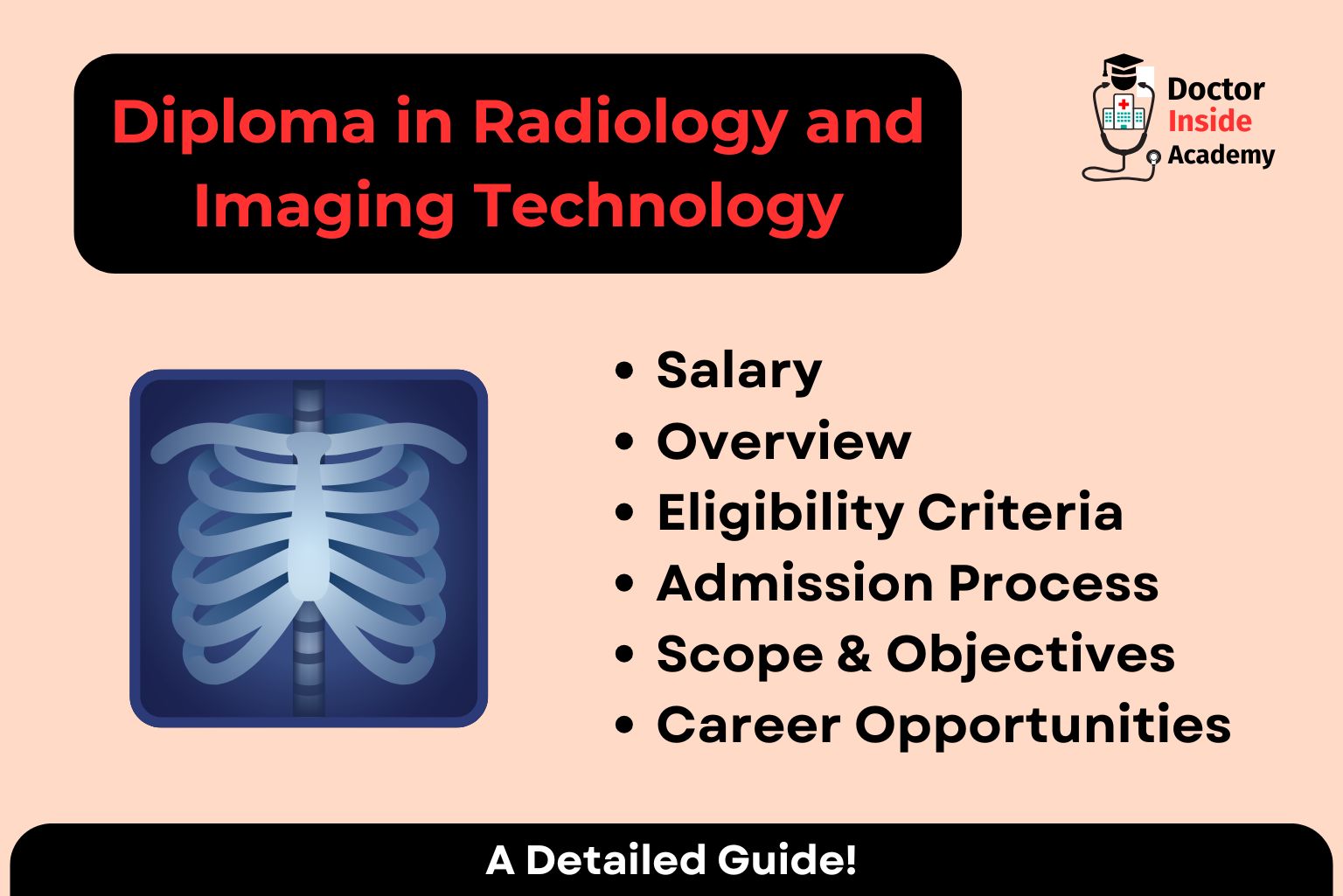
Diploma in Radiology & Imaging Technology
Duration
2 Years
Level
Diploma
Mode
Offline/Full Time
Overview of Diploma in Radiology and Imaging Technology
For those who wish to work in the medical imaging sector, the Diploma in Radiology and Imaging Technology programme offers in-depth training. Students will get a combination of hands-on training and regular academic classes to handle and maintain advanced medical imaging equipment, including MRI machines, CT scanners, ultrasound machines, and X-ray machines.
- Radiation safety protocols, anatomy, physiology, radiography techniques, patient care, and many other fundamental concepts are covered in this DRIT course.
- Students get practical experience while working with senior technicians to perform diagnostic imaging duties on patients at various clinics, hospitals, or diagnostic centres, or during clinical rotations in hospitals and imaging facilities.
- Graduates of the DRIT programme will have the skills and knowledge required to pursue entry-level positions as radiology technicians in a wide range of healthcare environments.
- DRIT provides a solid foundation for success in this life-saving and rapidly developing profession, whatever your passion in healthcare, or your desire for an enjoyable profession that involves offering patients the best diagnosis.

Radiology is an emerging medical science field, with many career opportunities in private and government hospitals or nursing homes. This course is already occupied with theory and practical sessions effectively.
Duration of Diploma in Radiology and Imaging Technology
- The average duration of a DRIT course is 2 Years + 6 Months Internship Mandatory.
Diploma in Radiology and Imaging Technology Includes
- Students who complete a diploma programme in radiology and imaging technology gain a fundamental knowledge of science, the human body, medical imaging technology, and patient care. These subjects are important for understanding how the human body works and the fundamentals of different imaging modalities. The course aims to give students the theoretical understanding necessary to carry out diagnostic imaging techniques safely and properly.
- With intensive hands-on training in several imaging modalities like X-ray, computed tomography (CT), magnetic resonance imaging (MRI), ultrasound, and fluoroscopy, the DRIT course is entirely focused on practical skills.
- Students gain knowledge of how to properly position patients, use innovative imaging modalities, and ensure that high-quality pictures are captured for accurate diagnosis. This diploma programme of study covers safety procedures that involve radiation exposure and patient protection.
- Modules on patient care, medical ethics, and communication skills are included in the curriculum in addition to technical training. These elements equip students to communicate with patients in a kind and professional manner, answering their questions and concerns while clearly outlining processes.
- Students who are knowledgeable about medical regulations, infection control, and ethical behaviour are more likely to maintain the highest standards of professionalism in the workplace.
- Graduates who complete the diploma programme are eligible to work as imaging or radiography technologists in clinics, diagnostic labs, or hospitals. By offering doctors high-quality pictures that support diagnosis and treatment planning, they serve a critical role in helping doctors.
- Additionally, the diploma provides access to higher education or additional specialisation in the linked medical imaging and radiology sectors.

DRIT Details
Particulars | Details |
DRIT Level | Diploma |
DRIT Duration | 2+1 Years |
DRIT Fees | 25k-90k* |
DRIT Admission Criteria | Entrance/Merit-Based |
DRIT Eligibility Criteria | 10/12th with 55% Marks |
DRIT Job Profiles | Radiologist, Radiology Nurse, Mammographer, MRI Technician, X-Ray Technician. CT Technician, etc. |
DRIT Salary | 10k-55k* |
- *Note - Its an educational data only, realtime data may be differ may be from given value here. So please verify that first.
Diploma in Radiology and Imaging Technology Eligibility Criteria
The eligibility criteria for a Diploma in Radiology and Imaging Technology vary slightly depending on the university or institution.
Here is the general eligibility for DRIT courses, commonly found across universities and colleges:
- Candidates must pass out from 10th or 12th in science stream with Physics, Chemistry, and Biology subjects.
- Candidates must have scored at least 50%.
- At the time of admission, candidates must be at least 17.
Any student who wants to get into Diploma RIT must be passionate about this course because their performance should reflect their interests.

DRIT Admission Process
Fill out Our Enquiry Form
Profile Evaluation by Experts
Get a Call Back from Our Counsellors
Scope & Objectives of Diploma in Radiology and Imaging Technology
Thanks to advancements in medical imaging technologies and an increasing demand for healthcare services, a diploma in radiology and imaging technology has an extensive and growing scope.

Thanks to advancements in medical imaging technologies and an increasing demand for healthcare services, a diploma in radiology and imaging technology has an extensive and growing scope.
Graduates of this programme can work in many places, such as clinics, hospitals, diagnostic labs, and private medical offices. To help with early illness identification and diagnosis, the programme gives students the skills and knowledge needed to function as radiology or imaging technologists.
The diploma program’s main goals are to give students complete training in radiography, radiation safety, and patient care. Graduates should have the following skills after completing the programme:
- accurately and safely perform diagnostic imaging procedures
- manage and look after imaging equipment
- produce high-quality images for diagnostic purposes
- effectively communicate with patients and healthcare professionals
- contribute to safe and high-quality patient care.
The diploma program’s goals also include training students for professional growth and lifetime learning. Graduates should be capable of:
- Keeping up with developments in medical imaging technology
- using evidence-based practices in their work
- Adjusting to evolving healthcare regulations and procedures
- advancing their careers through specialised training or additional study.
By accomplishing these goals, the program hopes to generate radiology or imaging techs who are capable, dedicated, and caring.
In the end, the goals and objectives of a diploma in radiology and imaging technology are in line with the more general objectives of boosting patient care and improving healthcare results. The programme equips students to contribute significantly to the healthcare system by giving them a strong foundation in medical imaging concepts and procedures.
This diploma is a desirable career choice for individuals interested in medical imaging, as there will likely be a greater need for qualified radiology and imaging technologists due to the increased emphasis on preventive care and early illness diagnosis.
Syllabus of Diploma in Radiology and Imaging Technology
The program’s curriculum is designed to provide a comprehensive understanding of radiology and imaging technology.
Here is an overview of the course content:
- Communication Skills
- Basic Computing Skills
- Medical Law and Ethics
- Professionalism & Values
- Human Anatomy & Physiology
- Principles of Management
- Medical Terminology & Record Keeping
- Introduction to Quality & Patient Safety
- Research Methodology & Biostatistics
- Conventional Radiological Equipment
- Basic Physics, including Radiological Physics
- Radiographic and Image Processing Techniques
- Introduction to Healthcare Delivery System in India
- Pathophysiology
- Radiation Safety
- Clinical Radiography
- Patient Positioning
- Anatomy & Physiology
- Quality Control in Radiology
- Physics of Newer Imaging Modalities
- Modern Radiological & Imaging Equipment
- Contrast & Special Radiography Procedures
- Imaging Techniques including Patient Care
Career Opportunities After Diploma in Radiology & Imaging Technology
Radiology students can pursue higher and better career opportunities. When the course has been completed, the potential candidates, with their skill set and aptitude scores, can enter different career paths. Graduates of Diploma in Medical Radiology Imaging Technology program can pursue various rewarding career paths.
Some of the job roles in DRIT include:

Radiologic Technologist

Imaging Technologist

Mammography Technologist

CT Technologist

MRI Technologist

Ultrasound Technologist

Mammography Technician

Radiography Supervisor

Imaging Department Manager

Radiology Assistant

Tutor/Educator
Diploma in Radiology and Imaging Technology Salary in India
Experience, location, and the type of healthcare organization are some variables that affect a Diploma in Radiology and Imaging Technology graduate’s salary in India.
In addition to DRIT pay in India, candidates get a glance at the following job profiles:
Role | Description | Salary Annually (INR) |
Radiologic Technologist | Performs X-ray exams to assist in diagnosis | 3,00,000 – 6,00,000 |
Imaging Technologist | Operates imaging equipment like MRI, CT, and ultrasound | 3,50,000 – 7,00,000 |
Mammography Technologist | Specializes in breast imaging using mammography | 3,50,000 – 6,50,000 |
CT Technologist | Conducts CT scans to produce detailed cross-sectional images | 4,00,000 – 7,50,000 |
MRI Technologist | Performs MRI scans for diagnostic purposes | 4,00,000 – 8,00,000 |
Ultrasound Technologist | Uses ultrasound equipment for diagnostic imaging | 3,00,000 – 6,00,000 |
Radiology Assistant | Assists radiologists and technologists in procedures | 2,50,000 – 4,50,000 |
Imaging Department Manager | Manages the imaging department operations | 8,00,000 – 15,00,000 |
Radiography Supervisor | Oversees radiography staff and procedures | 6,00,000 – 12,00,000 |
Tutor/Educator | Teaches radiology techniques and protocols | 4,00,000 – 9,00,000 |
Mammography Technician | Assists in mammogram procedures, patient preparation | 2,50,000 – 4,50,000 |
*Note – It depends on many factors; it’s an average metric shown here, for educational purposes only. Real-time statistics can vary from time to time and demand.
Get Free Counselling
FAQ DRIT
To pursue a BSc in Radiology and Imaging Technology, students must have completed the 12th with PCB/PCM, with a minimum score of 50%. At admission, the student’s age must be above 18 or above.
B.Sc in Medical Imaging Technology (B.Sc MIT) is a 3 to 4-year UG program that focuses on diagnostic imaging techniques, like X-rays, CT scans, MRIs, etc, used in healthcare to detect and diagnose diseases.
You will learn all these aspects: X-ray & Radiographic Techniques, MRI (Magnetic Resonance Imaging), CT Scan (Computed Tomography), Ultrasound & Doppler Imaging, Radiation Safety & Protection, Clinical Training in a Hospital.
After completing a B.Sc in Medical Radiography and Imaging Technology, a passed-out student can become a radiology technician, CT technologist, Nuclear Medicine Technologist, Radiation Therapist, Radiographer, Radiology administrator, Medical sonographer, Radiology assistant, and Radiology researcher.
Initially, students may expect a salary package of approximately 1.5 LPA as a Radiology staff, which can increase to approximately 3.5 LPA with your destination as a Radiology Assistant. They can make more money as an ultrasound technician, with an average compensation package of 6 LPA. The degree level that a student completes decides the pay expectation, based on their experience in the radiology diagnostic centres.
Some top employers for B.Sc in Medical Radiography and Imaging Technology students include well-known hospital brands such as Apollo Hospitals, Fortis Hospitals, AIIMS, Dr Reddy’s Pathlabs, and Padma Shree Diagnostic Center. Even government hospitals regularly hire B.Sc. in Medical Radiography and Imaging Technology students, where they can get a ton of practical experience.



